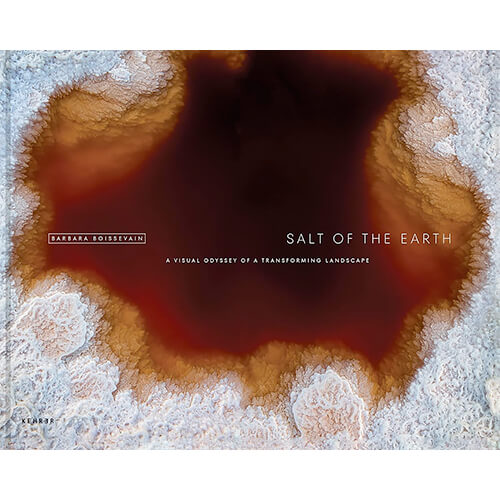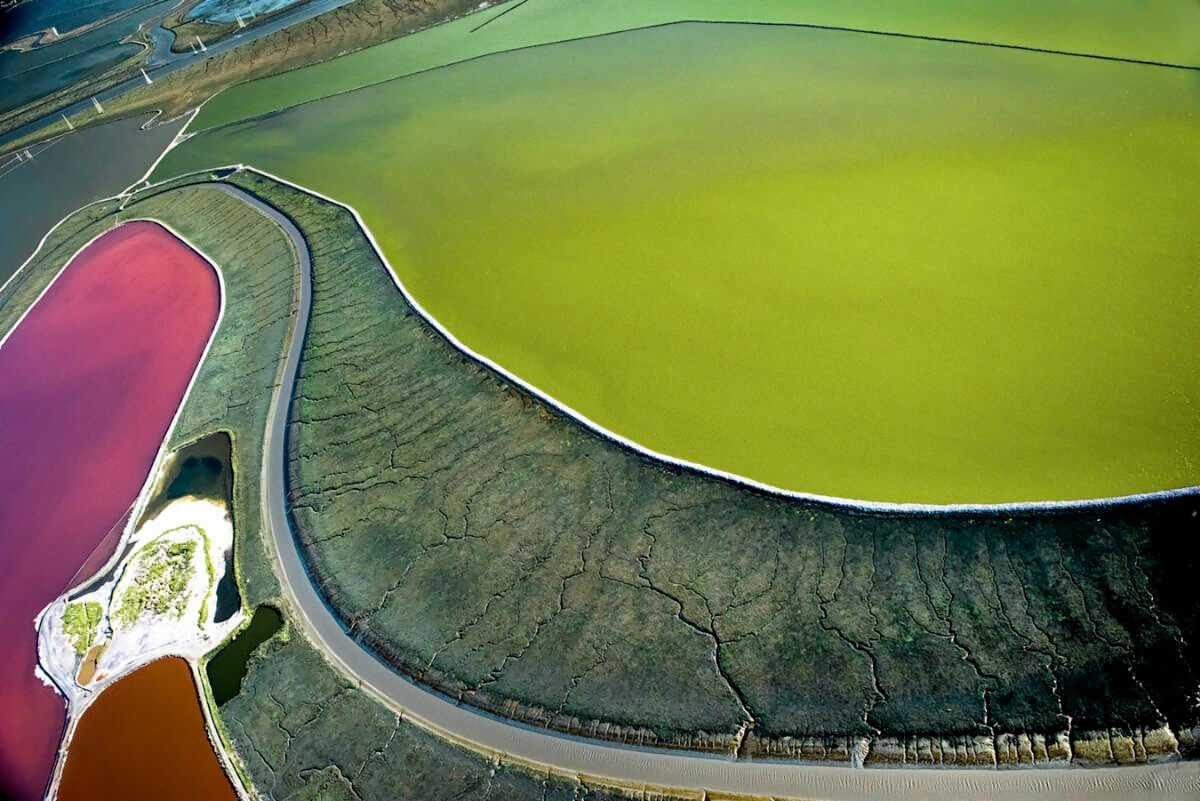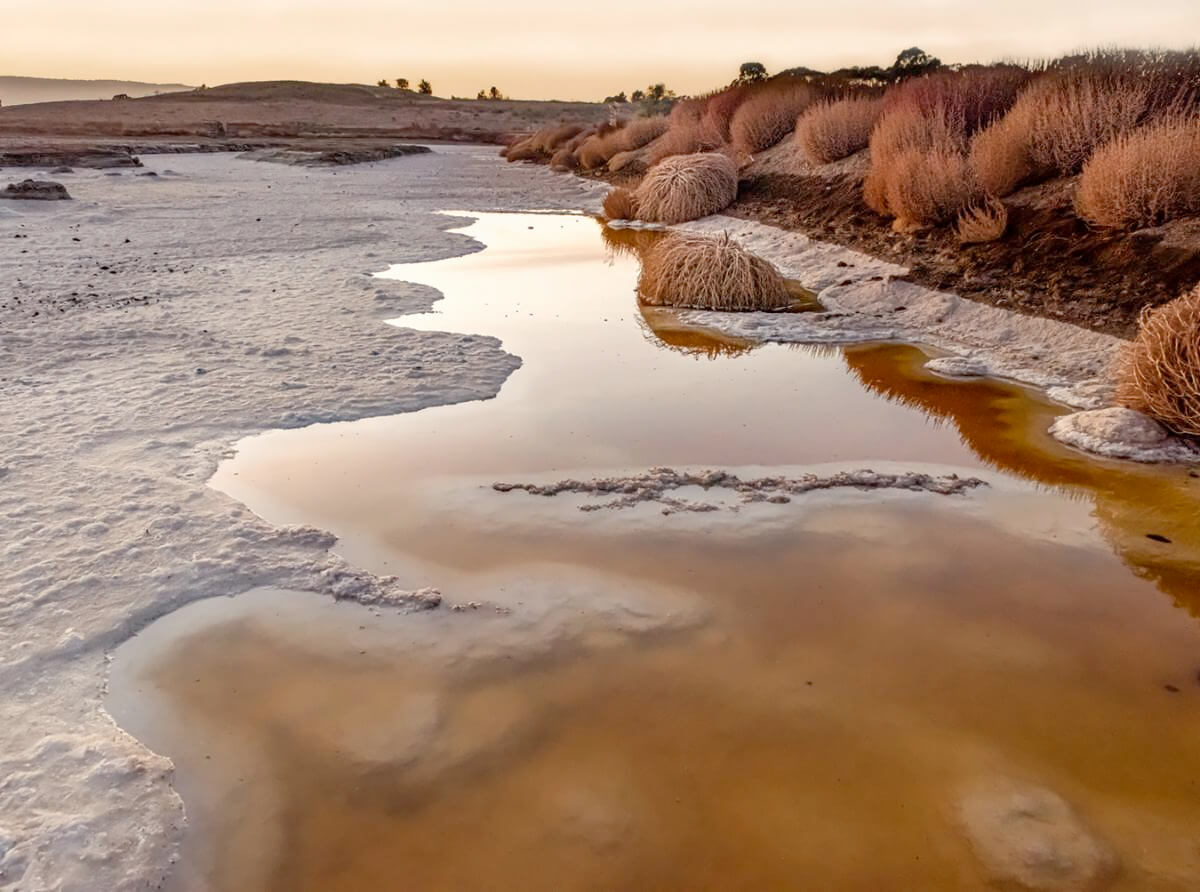''Boissevain’s pictures pivot between abstraction and representation. With compositions varying from single images to diptychs, to gridded abstract aerial formations coalesced with macro, landscape, and underwater imagery. Together, they build a fuller picture of the ecological wonder unfolding, and they combine to form a harmonious circular narrative of conceptual realism, renewal, rhythm, texture, form, and color.'' –Laura Noble
Twenty years ago, in the South Bay region of San Francisco, the South Bay Salt Pond Restoration Project was established to address the impact of human activity on the diminished marshes of the Bay and the role wetlands play in protecting vulnerable communities from sea level rise. This expansive environmental project is the largest tidal wetland restoration project on the West Coast and is dedicated to converting over 15,000 acres of commercial salt ponds at the south end of San Francisco Bay to a mix of tidal marsh, mudflat, and other wetland habitats.
Since the 1800s, the ecosystems of the tidal marshes have been replaced by salt ponds, and in her new book, Salt of the Earth: A Visual Odyssey of a Transforming Landscape (Kehrer), California-based photographer
Barbara Boissevain documents the efforts being made to return these spaces to their natural state. She thinks of her book, which explores the nexus of art, science and environmental activism, as a “love letter” to the San Francisco Bay where she grew up and raised her two daughters.
In Salt of the Earth Boissevain set out to document humanity's impact on the environment and raise awareness of the need for preservation of pristine spaces. In addition to the salt industry's impact on the biodiversity in these regions, the natural systems of the wetlands are a barrier to the encroaching sea level and work much better than the man-made levees that existed to trap the salt water and harvest the salt for the salt industry.
The book combines several visual perspectives of the area–aerial, ground, and underwater–allowing the viewer to see the scope of the damage to the landscape, and the beginnings of transformation. Boissevain comments on how the images work together to present a more comprehensive narrative of the issues at hand, as well as the progress being made so far. She also notes,
''The images in the book offer unique perspectives, allowing me to reveal wound-like openings in the earth where signs of new life are just beginning beneath the water. Within this immersed world, I was intrigued to find textures and patterns mirroring the ones I had captured when photographing from the air. I took this discovery to be a sign that I had come full circle with this project.''
Boissevain began the project in 2010 with aerial photography taken from a helicopter. After several years of documenting the salt ponds in this way, she began grouping the images in grids based on palette to present another angle of transformation to the landscape. The high salinity environment resulted in color schemes she has called 'apocalyptic.'
Then in 2020 she began photographing from the ground at the region's national wildlife refuge created in the 1970s, and at the Ravenswood salt ponds bordering the Meta/Facebook headquarters. On her website, the artist points out, These images hint at the vast technology sector that protrudes from the horizon looming just on the other side of the ponds. The cracked surface of the earth looks almost like an alien planet juxtaposed next to the opulent, manufactured structures cocooning the social media headquarters. The dystopian nature of these images reflects the dissonance between man and nature that I see threatening our planet and the disproportionate influence these companies have on our future.”
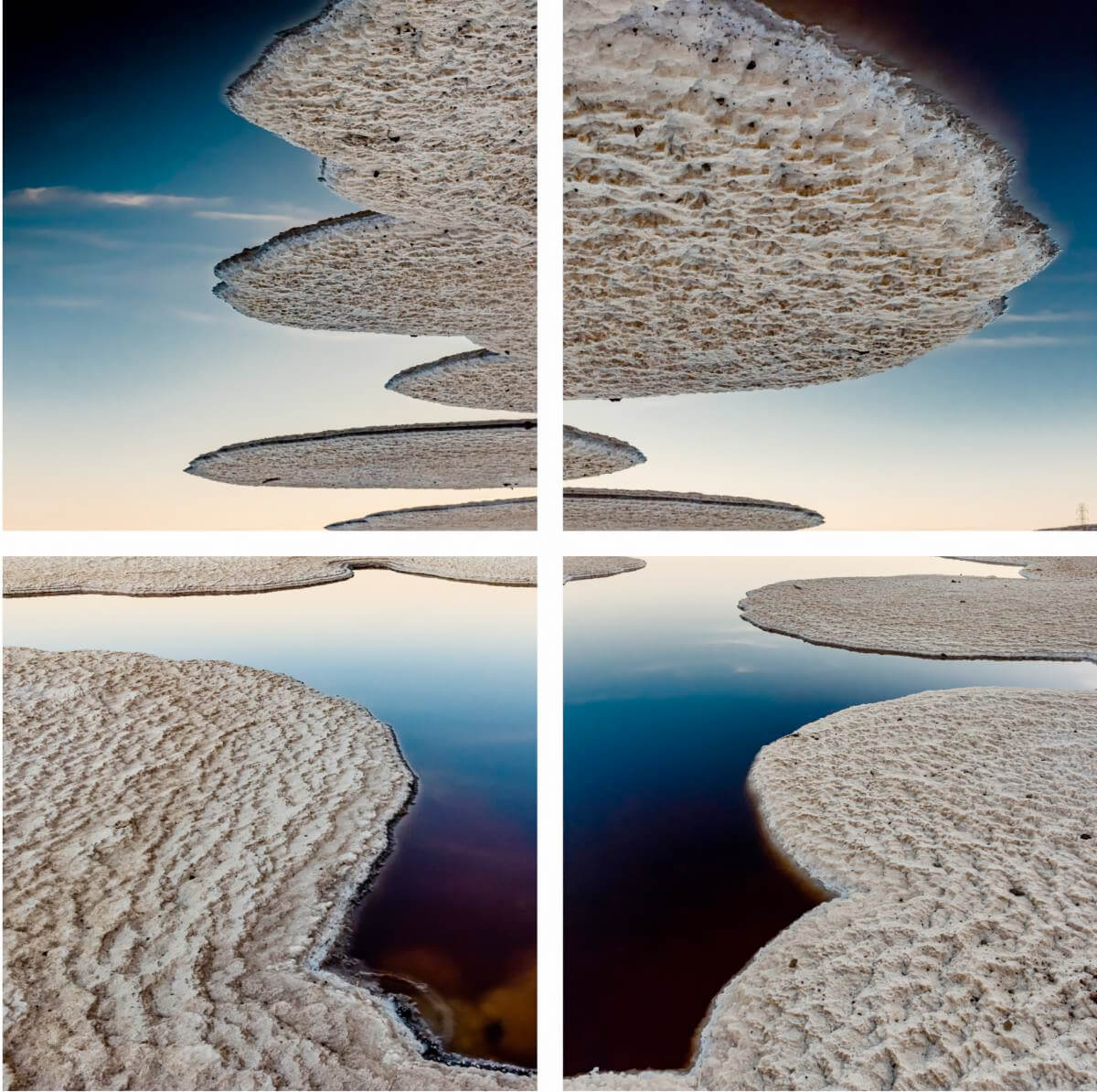
Michael Honneger interviewed Boissevain and this conversation with the artist provides personal and direct insight into her process and motivations. They discuss details of the project's origins in 2010, obstacles she faced such as funding, and the interesting impacts of the Covid lockdown, which provided more time to consider the shape of the project and it was then that she decided to include the ground level perspective. She shared, It needed to become more intimate, and I wanted my connection to this place—where I was raised and where I raised my own family—to come through in the photographs.
The book includes maps of the San Francisco Bay area, highlighting the surrounding cities and towns and cultural markers, along with keys of the natural elements, reinforcing the proximity and relationship between nature and negative human impacts. A map and informational plate around a selection of the ecosystems present within the tidal salt marsh environments accompany the photographs in the book.
Near the end of the book, the artist has provided a list of all the plates, their titles, location, distance from the subject, and anecdotal or informational details that provide a deeper context and more reflection points for the viewer.
Stanford professor Elliott White Jr., Ph.D is a fellow at the Stanford Woods Institute for the Environment and in his essay for the book, he considers the historical, economic, and political implications of environmental justice in the wake of the climate change devastation evident throughout the world. He writes, Environmental stewardship with a focus on equity moves us one step closer to a just world.
About the artist:
Barbara Boissevain is a contemporary visual artist and photographer, based in Palm Springs, California, whose work focuses on the impact of human activity on the environment. Nature’s ability to regenerate and reclaim human altered landscapes is a central theme in her work. Boissevain was born in Cleveland, Ohio and raised in Silicon Valley. She studied painting at Parsons School of Design in New York before immersing herself in photography, earning a BFA from the San Francisco Art Institute and an MFA from San Jose State University. Her work has been exhibited in solo and group exhibitions throughout the United States and Europe, including Mémoire De L’Avenir, Paris; the Institute of Contemporary Art, San Jose, CA; Galerie Numero Cinq, Arles, France; the Academy of Fine Arts in Krakow, Poland; and the David Brower Institute in Berkeley, CA. In 2009 Boissevain published her first book, titled Children of the Rainbow, which documented the humanitarian challenges facing Quechua communities in Peru due to climate change. In 2021 her work was featured on NPR’s “The Picture Show” in conjunction with the UN Climate Change Summit in Glasgow, Scotland. She was also featured on the PBS News show Something Beautiful In 2022. Boissevain’s photographs are in public and private collections, including the Google Corporate Art Collection, Sunnyvale, CA; De Pietri Artphilein Foundation, Lugano, Switzerland; and Galerie Huit, Arles, France.
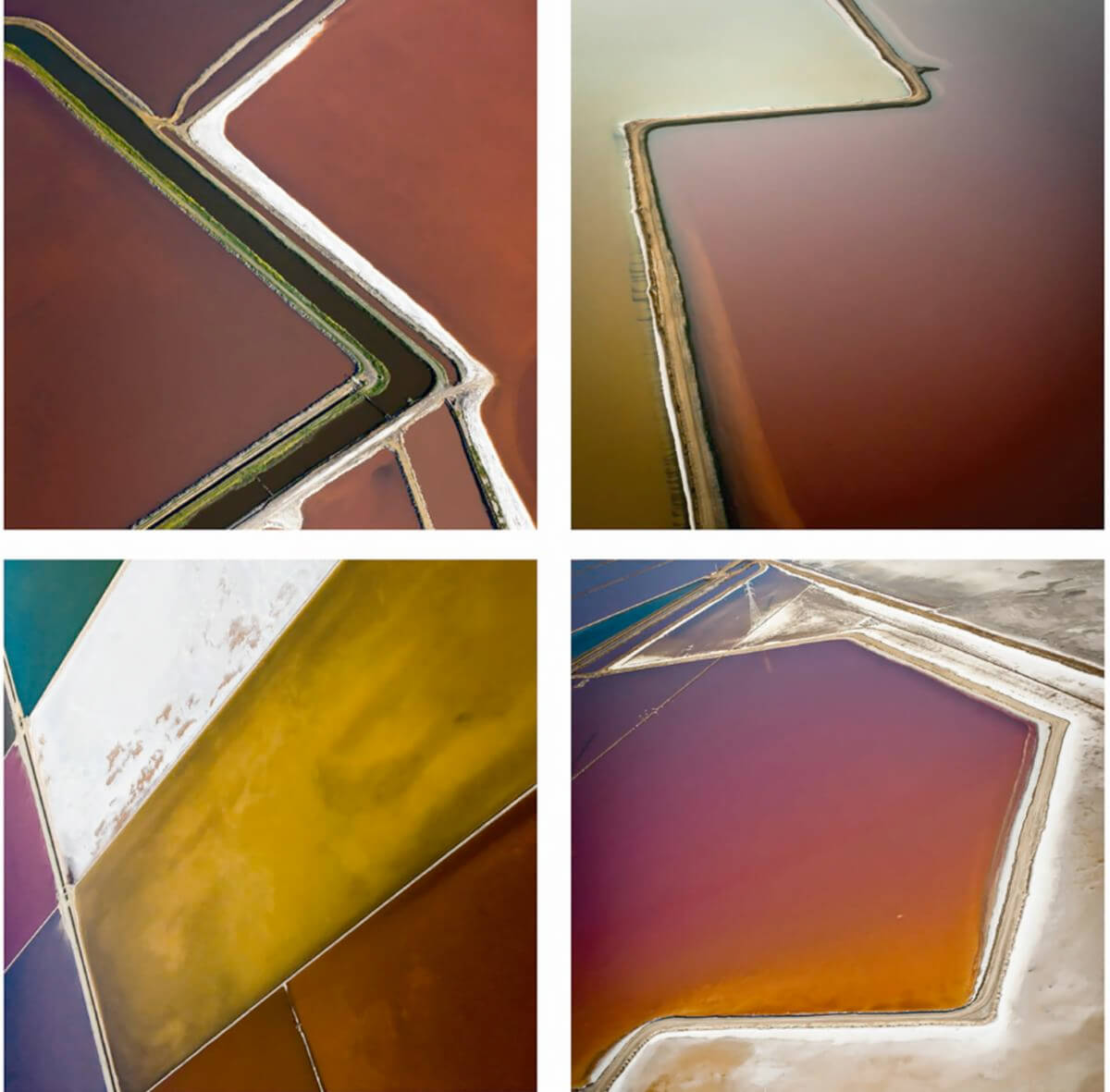
is the author of sixteen books and several hundred other published works, and winner of the James D. Phelan Award, the Commonwealth Club Medal in California, and the David R. Brower Award for Service in the Field of Conservation. He also works as an editorial consultant on public involvement documents in the planning and environmental fields.
Michael Honegger is a visual artist born in Germany and the European Editor of Lenscratch, an online platform dedicated to supporting the photographic arts and artists. He has exhibited his work in numerous juried group shows throughout the United State and Europe including the Center for Fine Art Photography, Photo Place Gallery, A.Smith Gallery, the Southeast Center for Photography and P.H. 21 Gallery among others. His documentary project on the refugee crisis on the island of Lesvos, Greece in 2015 was widely published in major European newspapers and by Amnesty International in their initial press release on the crisis.
Laura Noble is the founder and Director of L A Noble Gallery in London (LANG) launched in 2012 and FIX Photo Festival since 2016. She is also a multidisciplinary artist, curator, and author of The Art of Collecting Photography, with primary essays in many photobooks including monographs, catalogs and anthologies alongside articles for numerous journals worldwide.
Elliott White Jr., Ph.D is an assistant professor of Earth System Science at Stanford University and a fellow at the Stanford Woods Institute for the Environment. He is a coastal ecosystem scientist that studies the effects of saltwater intrusion and sea level rise (SWISLR) on vegetation in the coastal land margin. His research experience in wetlands spans the North American Coastal Plain of the US, in addition to constructed prairie potholes in Iowa. His interdisciplinary approach to research draws from ecology, hydrology, biogeochemistry, and remote sensing.
